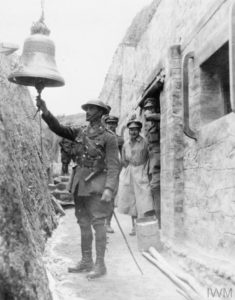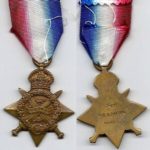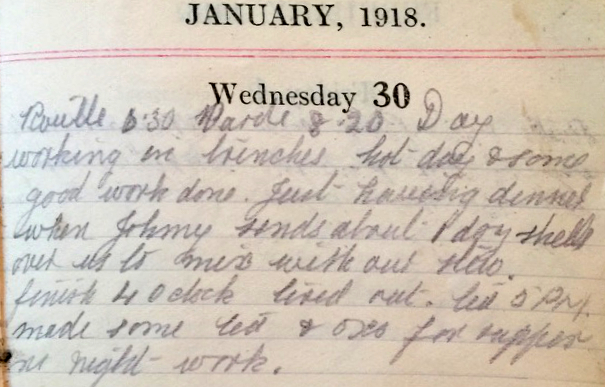Wednesday Jan 30th, 1918
Reveille 6:30. Parade 8:20. Day working in trenches. Hot day and some good work done. Just having dinner when Johnny sends about one dozen shells over us to mix with our stew. Finish 4 o’clock tired out. Tea 5pm. Made some tea and Oxo for supper. No night work.
Gas Attack

This evening an officer from Anti-Aircraft 98 Battery reports gas shells bursting in Pearse Ravine and subsequently ‘all precautions (are) taken’. Gas was one of the most terrifying weapons used in the war. It was deployed by both sides in the conflict.
An early warning system for countering gas attacks was essential. This photograph shows a church bell being used as a gas alarm outside a large concrete bunker on the Dojran Front.
Gas masks were essential and increasingly effective. By 1917 small box respirators were widely used. These became a prized possession of the Tommy and helped minimize casualties. However over the course of the war, 1.2 million soldiers in many theatres of war were wounded in gas attacks and a further 90,000 died. These numbers, while bleak, don’t tell the whole story. Many victims suffered long-term, debilitating ill effects for the rest of their lives, including blindness and tuberculosis.
Artists probably reveal best why it was one of the most terrifying weapons used in the war. John Singer-Sargeant painted this haunting scene which he had witnessed near Arras in summer 1918. It is simply called ‘Gassed’:

Similarly, Wilfred Owen wrote ‘Dulce et Decorum est’ in 1917. Owen, who was arguably the greatest of the British war poets, died in France just days before the Armistice. The second verse is shown here and the complete poem may be accessed through the link at the bottom of this post:
Gas! GAS! Quick, boys! — An ecstasy of fumbling,
Fitting the clumsy helmets just in time;
But someone still was yelling out and stumbling,
And flound’ring like a man in fire or lime …
Dim, through the misty panes and thick green light,
As under a green sea, I saw him drowning.
In all my dreams, before my helpless sight,
He plunges at me, guttering, choking, drowning.
Medals at Janes

Today the Battalion diary reports the 13th being represented at the investiture of the 1914 Bronze Star. The Bronze Star was awarded to troops who had served in France or Belgium between the outbreak of war (August 5th 1914) and the end of the First Battle of Ypres (22-23rd November 1914). Its award had been announced under Special Army Order 350 in November 1917.
13th (Service) Battalion War Diary – 30th January 1918 – Vladaja Camp
A company of the 9th Border Regiment (Pioneers) is taking over all dugouts, CT (communication trenches – Ed) and entrances to them on Tortue from D Coy. Thus releasing more of the latter Coy to work on the Main Reserve Trench, the Left Reserve Trench and ST4. RMS HW Bretton represented the battalion at the investiture of the ?? Ribbon of the 1914 bronze star, held at Janes by the Commander in Chief, British Salonica Force. At about 22:30 hrs an officer of A98 Battery RFA (Vladaja) reported gas shells bursting in Pearse Ravine, all precautions taken. Following OR struck off effective strength under GRO 1011 as under – 2 from 29-1-18 and 1 from 30-1-18. 1 OR having rejoined form FA is again taken on strength from 24-1-18.
References & further reading
Chemical Weapons in WWI, Wikipedia
Dulce et Decorum est, Wilfred Owen, Viking, 1921
Gassed, copyright IWM
1914 Star in Wikipedia



One thought on “Gas Attack – January 30th, 1918”
Comments are closed.